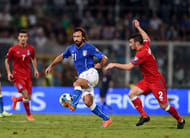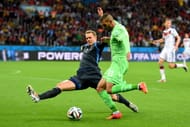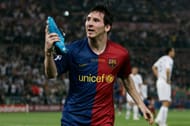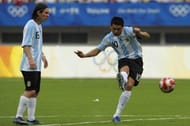When I started following the game I was more than baffled to see Claude Makelele being given plaudits and praises for not even being in the spotlight. For all I remember, he was out there somewhere in the background when all the goals were being scored and people were going bonkers about players like Didier Drogba and Frank Lampard. But I soon realized the fallacy, and no wonder he made a mark on the game and the resurgence of what is today a mean successful blue machine by the name of Chelsea FC.His positioning, his method of breaking up play, as well as his shielding of the back four was so meticulous, yet so placid. He was soon seen as an example for everyone; thus creating the Makelele role.On the face of it, it is a central defensive midfield role. But to be so adept at it so as to redefine the position and to have people refer to that position as your position is an insurmountable feat. It is the sort of thing payers live for, to be etched into history for your noble contribution to the game.While Claude Makelele was one example, recent history has shown us that time and again players become the quintessential example for the role they play on the pitch. Here are five such players who revolutionized various roles in football as we see them today.
#5 Regista/Deep lying Playmaker - Andrea Pirlo

There are players who do not feel right on the pitch, but appear languid, easy going and less athletic than the rest. Andrea Pirlo was all of these and more but what changed how we perceive him today is due to a slight change in his actual playing position.
Pirlo started out at as an attacking midfielder but was soon seen not fit for it, thus he was given a much more central role. Soon he was converted into a Regista, an Italian term for Deep lying playmaker. His role was burnished during his time at AC Milan where he played in some of the greatest midfields as well teams of the last two decades. Particularly with Carlo Ancellotti as manager at San Siro, Pirlo came into prominence for being this lynchpin that we are aware of today.
His biggest strength is not just initiating attacks which he is more than adept no doubt but setting pace of the game so as to suit the team’s requirement.His metronomic passing is the pulse of midfield and releasing players through on goal is what he has made his mark with.
It was a role prevalent long before Pirlo, but in the modern day game we have been taught to treat the role as “The Pirlo Role”. Any player who plays deeper in midfield without offering much of the defensive roadblock duties is seen as playing the “Pirlo role”. Be it Bastian Schweinsteiger or Ricardo Montolivo (the man chosen to replace Pirlo at Milan) the role provides a better link between the defense and the attack for teams who can afford to play that way.
#4 Sweeper Keeper - Manuel Neuer

In order to help out the goalkeeping fraternity maintain that Mad Hatter profile, Manuel Neuer had much work to do. But he made sure that he did his fellow goalies proud.
A solid goalkeeper from the very beginning, Neuer was one of the next big things from Germany during his youth days. Lending meaning to their nickname FC Hollywood, Bayern Munich bought him from FC Schalke for an exorbitant price. And to be fair, Neuer was actually worth the €22m they spent. He, as expected took this transfer with aplomb and continued his good vein of form.
But it was last year as Bayern went on to secure the services of Pep Guardiola that he was seen as this new breed of Sweeper Keeper, plugging the attacks before they even entered the 18-yard box. His ability with the foot has been tremendous in altering his ways as a shot stopper.
The approach of playing a high line is considered risky business, particularly on counters. But with a goalkeeper like Neuer at the helm, it has given Bayern an extra dimension in their play. They are more than assured that their goalkeeper would be there to clear the danger.
Some may even consider it plain deprecating of the opponent to play the goalkeeper so high up that he is sometimes perceived as an outfield player. Others consider it a sign of mayhem to see a goalkeeper running helter-skelter out of his area. The tactics of a sweeper keeper actually has the method to all the perceived madness.
Granted when things go awry, it makes the keeper look foolish. But when it works, it works like a charm. The urgency of the keeper in the system is as much as clearing the ball as well as pressing the opponent. It would not be wrong to say that Pep Guardiola, who was unsuccessful in changing Barcelona to a three men defense system, might be able to succeed at Munich partly because of what he gets from Neuer.
#3 Inverted winger - Arjen Robben and Cristiano Ronaldo

Inverted Wingers are wingers with panache for cutting inside and/or playing through the centre. While the archetypical winger is someone like Jesus Navas – a player who likes to hug the touch line and take defenders on while delivering the ball into the 18-yard box – the tactic of allowing anarchy to flourish amongst the front three is quite prevalent. No one has a fixed position, fluidity has been key to many a modern teams, be it Barcelona or Bayern Munich.
Arjen Robben is a stereotypical example of a winger who likes to drift in from their weaker side to their favoured foot. These players like to play on their opposite side (left footed players starting on right wing and vice versa). He can be tagged as the leading proponent of this breed of wingers. But the player who has equally contributed to changing the trajectory of this position is Cristiano Ronaldo, who in his time at Real Madrid has made this role his own.
The Portuguese star offers way more than what an archetypical winger does and has the height as well the attacking prowess to cross the ball as well be a recipient of the same in the box. Ronaldo, like Robben likes to cut inside. And with his pace, he helps unsettle the opponent thoroughly, making the task of his team mates a tad bit easier.
While Robben is clearly positionally more of a stereotype, in the sense that we know he will be on the wings looking to cut in while Ronaldo is a bit more liberated in his role.
#2 The False 9 - Lionel Messi

Lionel Messi leading the lines seemed like a joke initially. How could a diminutive player like Messi be given the position that stereotypically requires certain robustness and body strength was everyones retort. But Pep Guardiola, never shy of making audacious tactical moves, stuck to his guns and utilized Messi as a number 9, albeit a false one.
The false 9 has now become a pretty common tactical ploy used by clubs and countries all over. This widespread use and success of the tactic can be attributed to both Pep Guardiola and Lionel Messi. Though per se, the position is not something new to the game, with Roma finding great success deploying Totti as their false 9 even before Messi started playing that position, but no doubt Messis spell at this position is something that has made him synonymous with it.
Messi started out as a right sided winger with a penchant to drift to his left side. But with the arrival of new coach, Guardiola, Messi started gaining much more credence in the team. This was evident from the fact that first, Samuel Etoo, the fulcrum of Barcelonas attacking line up was asked to play on the right and then, deemed surplus to their requirements and then the next star signing, Zlatan Ibrahimovichad a fallout with coach due to the fact that he had to play wide or deep so as to accommodate Messi as a false 9.
Ultimately Zlatan and Barcelona parted ways and after that Barca won every trophy under the sun with Messi being at the heart of the attack. Coming from deeper positions, which as a false 9 he was able to procure, taking on defenders and ruling the roost
Messi has in certain aspects been helped by the composition and ethos which Barcelona have. Their tiki-taka play is more than just conducive to his success in a false 9 role. As a false 9, one of the critical parts of the job is to make use of the space left between yourself and the defense that keeps on developing as and when youdrift. Barcelona had a team filled with sensational talents that could do that with elegance and hence theirsuccess with the system in the past 5-6 years.
#1 Juan Riquleme - Number 10 role

Juan Roman Riquelme remains one of those players who has enthralled tacticians of the game for many reasons for a long time.
Riquelme is somewhat of a talisman in tactical parlance. He was very crucial as he helped revoulutionize how we see the game today. He is the last vestige of the breed of static playmakers, the number 10 who played in the “hole” and was deputized with orchestrating the creative outlook of the team.
The “old school” no.10s were earmarked for that sort of role only; making the attacking line tick while doing nothing or having very little presence when the team had to defend. With constant change in the game, improvements in fitness as well as a majority of sides moving to a three men midfield, the number 10s slowly started losing their sheen.
While they were seen as imperative at their best, they also had to do with the label of being passengers on the pitch when they had no possession to dictate the pace of the game. This was pretty much the reason why the playmaker role was chiseled out to suit the current scenario.
Now we see a great variety in the playmakers of the team. Some start on the wing, some drift to the side, some like to start a bit deep and then make their moves. Wesley Sneijder, Luka Modric, Cesc Fabregas and Mesut Ozil are the new age playmakers – all of whom are much more dynamic along with their creative game play.
They play in the hole but are wholesome with respect to what they offer to the team.
